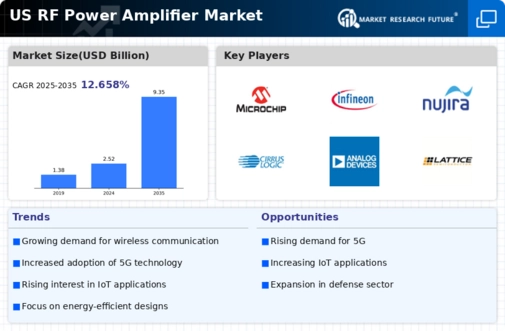Surge in Wireless Communication
The increasing reliance on wireless communication technologies is a primary driver for the rf power-amplifier market. As the demand for high-speed data transmission escalates, particularly with the advent of 5G networks, the need for efficient power amplifiers becomes critical. The rf power-amplifier market is projected to witness substantial growth, with estimates suggesting a market value exceeding $5 billion by 2026. This surge is attributed to the necessity for robust signal amplification in various applications, including mobile devices, IoT devices, and satellite communications. Furthermore, advancements in semiconductor technology are enabling the development of more efficient amplifiers, which are essential for meeting the stringent performance requirements of modern wireless systems. Consequently, the expansion of wireless communication infrastructure is likely to propel the rf power-amplifier market forward.
Expansion of Consumer Electronics
The proliferation of consumer electronics is significantly influencing the rf power-amplifier market. With the increasing integration of wireless capabilities in devices such as smartphones, tablets, and smart home appliances, the demand for high-performance power amplifiers is on the rise. The rf power-amplifier market is expected to benefit from this trend, as manufacturers seek to enhance the performance and efficiency of their products. In 2025, the consumer electronics sector is anticipated to contribute approximately $1.5 billion to the rf power-amplifier market. This growth is driven by the need for improved signal quality and range in consumer devices, which necessitates the use of advanced power amplifiers. As technology continues to evolve, the rf power-amplifier market is likely to see further innovations tailored to meet the demands of the consumer electronics landscape.
Emergence of Smart Grid Technologies
The transition towards smart grid technologies is emerging as a significant driver for the rf power-amplifier market. As utilities seek to enhance the efficiency and reliability of power distribution, the integration of advanced communication systems becomes essential. The rf power-amplifier market is likely to see increased demand as smart grid applications require robust signal amplification for data transmission between various components. The market is projected to grow by approximately 8% annually, driven by the need for real-time monitoring and control of energy systems. This growth is further supported by government initiatives aimed at modernizing the electrical grid, which will likely necessitate the deployment of advanced rf power amplifiers to facilitate effective communication within smart grid infrastructures.
Rising Demand for Automotive Applications
The automotive sector is increasingly adopting advanced communication technologies, which is positively impacting the rf power-amplifier market. With the rise of connected vehicles and the implementation of V2X (vehicle-to-everything) communication systems, the need for efficient power amplifiers is becoming more pronounced. The rf power-amplifier market is expected to grow as automotive manufacturers integrate these technologies to enhance safety and navigation systems. By 2026, the automotive segment is projected to account for around 20% of the total rf power-amplifier market. This growth is driven by the necessity for reliable communication in various automotive applications, including infotainment systems and advanced driver-assistance systems (ADAS). As the automotive industry continues to evolve, the demand for high-performance rf power amplifiers is likely to increase.
Increased Investment in Defense and Aerospace
The defense and aerospace sectors are becoming increasingly reliant on advanced communication systems, thereby driving the rf power-amplifier market. The need for secure and reliable communication in military applications necessitates the use of high-performance power amplifiers. The rf power-amplifier market is projected to experience growth as defense budgets in the US continue to expand, with an estimated increase of 5% annually over the next five years. This investment is likely to enhance the development of sophisticated communication systems, including radar and satellite communications, which require efficient power amplification. As a result, the rf power-amplifier market is expected to benefit from the heightened focus on technological advancements in defense and aerospace applications.
























Leave a Comment